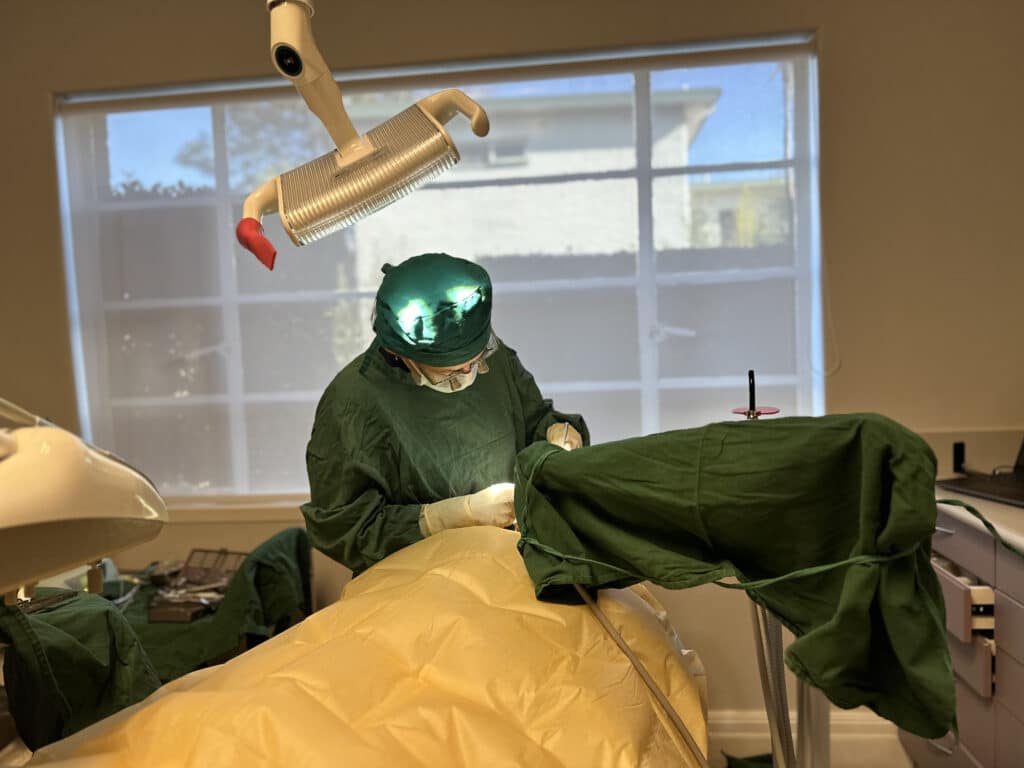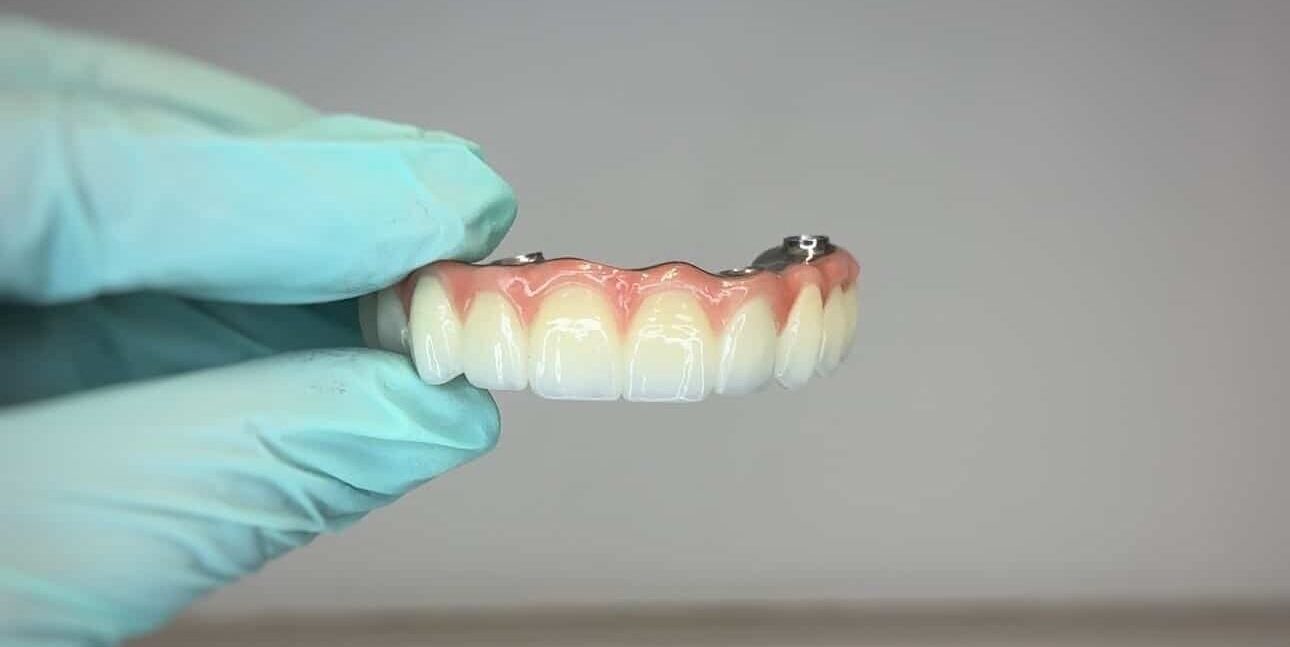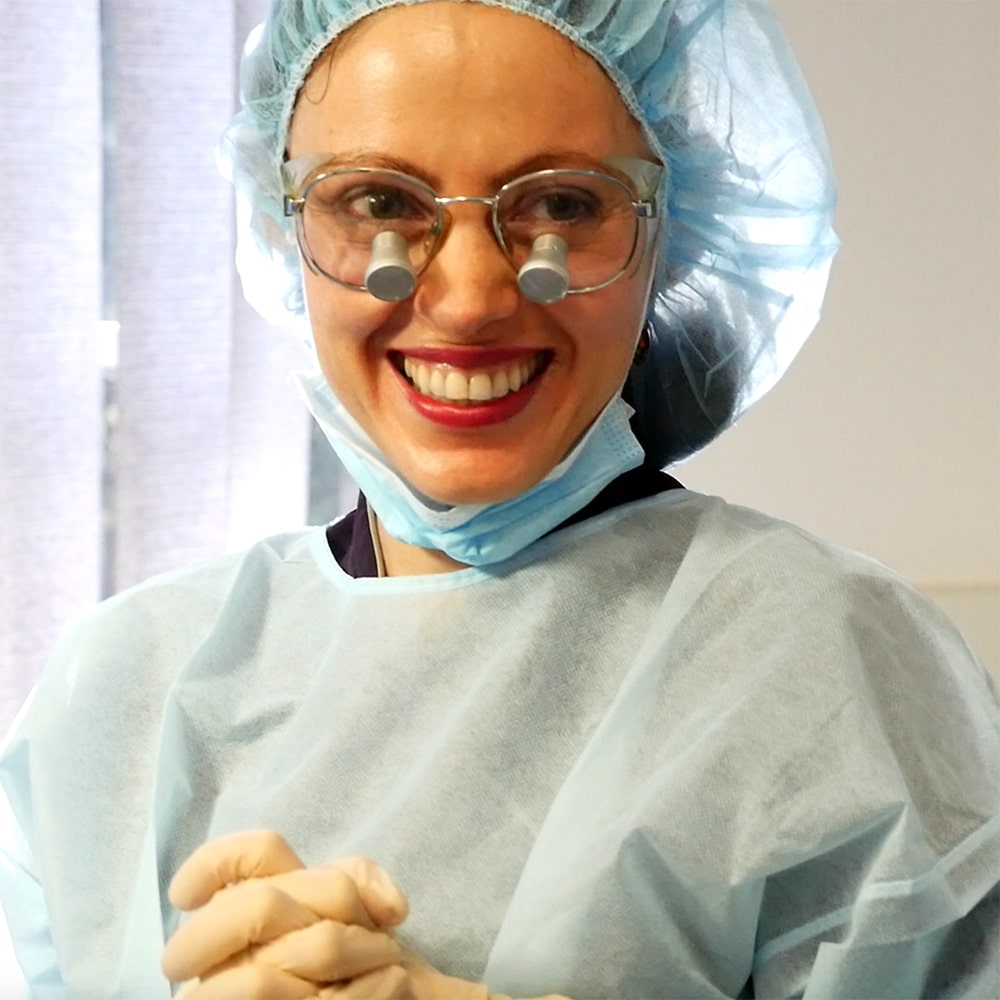Suppose you have lost all hope in your teeth and are considering replacing them with dental implants, or you have been wearing full dentures and want to eat comfortably again. In that case, you will have many questions about the process, realistic outcomes and cost.
I’ve consulted thousands of patients before undergoing All-on-4 treatment, and they all have similar questions to ask me about full-mouth dental implants, so I’ve put together a list of the 10 most common ones.
Before we start, I want to mention that I’m not promoting any specific implant brand. The terms “All-on-4”, “All-on-6”, “Teeth in 1 day”, “Teeth in 3 days”, “All-on-X” and “Full Mouth Implants” are often used interchangeably. While “All-on-4” is a trademarked concept by an implant company called Nobel Biocare, it simply refers to a treatment approach where all of your teeth are replaced using implants, often in a way that avoids bone grafting. Even though the name suggests four implants, it doesn’t always mean that exactly four are used in every case. Sometimes more implants offer better support, and are therefore referred to as “All-on-6”.
The idea is to replace all teeth in the upper or lower jaw with a fixed set of teeth supported by a few strategically placed implants. This approach is popular because it provides a full set of teeth within days of the surgery, and is more cost-effective than the conventional approach.
Here are the 10 most common questions patients ask about “All-on-4”.
1. How do All-on-4 Implants work?
All-on-4 refers to the replacement of all teeth with four titanium implants in each jaw. However, sometimes five or six implants are used for added stability. While four implants are generally enough, more implants (“All-on 5” or “All-on-6”) can provide better long-term reliability.
The process typically starts with tooth removal and implant placement, often done in the same visit. Within a day or two of your surgery, you’ll receive your temporary teeth so that you can return to your regular activities promptly. Implants need 3-5 months to fuse with your jaw bone, a process referred to as osseointegration. You will need to eat minced and mashed foods for the duration of this osseointegration process to ensure no pressure is applied to your new teeth. If you start biting and chewing with your immediate teeth prematurely, implants are likely to fail. Think of it as a broken leg – just as you wouldn’t put weight on a broken leg while it is healing, you shouldn’t put pressure on the implants until they fully integrate with your jawbone. Rest assured you will have a gorgeous smile to carry on with your life, but you will have to be very careful eating until implants fully integrate. Once implants are fully integrated, you can enjoy eating just about anything you like.
Once your implants are fully integrated, we replace your temporary bridge with a final, definitive one. You have a few options for the final restoration. The most popular and cost-effective option is a titanium-reinforced acrylic bridge, or you could upgrade to stronger titanium-reinforced zirconia teeth. Another option is a removable denture instead of a fixed bridge. We call these “fixed-removable teeth”. It might sound like a contradiction but they do feel fixed until you pull hard on them to dislodge them. An implant-retained denture is not to be confused with a regular one. These dentures snap onto the implants and don’t move around like traditional dentures. An advantage is that you can take them out for cleaning or at night to prevent damage and wear due to night grinding.

2. Are All-on-4 Implants worth it?
All-on-4 dental implants are absolutely worth it. I’m not just saying that because I’m the dentist who does them, but because thousands of patients at Dr Helen’s Implant Studio have told us how life-changing this treatment has been for them. Imagine going from loose dentures to fixed implants, or from decayed teeth and constant pain to a stable, comfortable set of teeth. The transformation is incredible and can truly improve the quality of life.
That said, it’s important to understand that this isn’t a simple procedure. All-on-4 involves a complex surgery and takes several months from start to finish. It is not a replacement for healthy, natural teeth that can be restored as implants will never be as good as your natural teeth and will require long-term maintenance. It’s also a significant financial investment, costing thousands of dollars, with very limited coverage from Medicare or insurance.
Deciding to get All-on-4 implants is a big commitment, both physically and financially. However, based on the feedback from my patients, I can confidently say that despite their limitations, if you have lost your teeth or are about to lose them, you will be better off with All-on 4 than without them. The long-term benefits of having fixed, comfortable teeth make a huge difference in people’s daily lives and overall well-being.
3. What do All-on-4 Implants look like?
With All-on-4 dental implants, the implants themselves are hidden beneath your gums, so you won’t actually see them. What’s visible are the bridges (prosthetic teeth), which include artificial gums and teeth. These teeth can be customised to fit your ideal smile, whether you want a perfectly polished look or something more natural.

With some realistic expectations, we can tailor your smile to your preferences. Want perfectly straight, white teeth? No problem. Prefer a more natural look with small gaps or slightly varied shapes? We can do that too. We can make your teeth longer, shorter, whiter, or darker, depending on what suits you best. If you want a specific look, it’s helpful to bring in old photos of your original smile or find images online that reflect your vision.
While there are some limitations with full mouth replacements, we can usually achieve the appearance you desire. Whether you’re dreaming of a Hollywood smile or something that looks like your natural teeth, we can work with you to design the perfect result. Your new teeth will not only look great but will also function comfortably, giving you confidence in your smile again.
4. Are All-on-4 Implants permanent?
While dental implants are durable, they aren’t always permanent. Over time, they may require maintenance or replacement. However, with proper care, they can last a long time. Interestingly, the implants themselves often outlast the bridges (the prosthetic teeth) attached to them. We often see bridges needing repairs or replacements after a few years. Sometimes, a tooth may break off, or the body of the prosthetic teeth might fracture. In some cases, the bridge can be repaired, while other times, it needs to be replaced entirely.
For people who grind their teeth, it’s essential to wear an occlusal splint at night to protect both the implants and the bridge. Failing to do so increases the risk of fractures or even implant failure. Another potential issue is peri-implantitis, a type of gum disease that affects implants, for which we have limited treatment options.
To make your All-on-4 implants last as long as possible, it’s crucial to choose a skilled surgeon and follow a good maintenance routine. We’ll guide you on how to care for your implants to help ensure their longevity. With regular checkups and attention to home care, you can greatly reduce the risk of complications and enjoy the benefits of your implants for many years.
5. How Much Do Full Mouth Implants Cost?
One of the most common questions we get is: “How much do All-on-4 implants cost?” When thinking about the price, there are three main factors to consider: the cost of surgery and prosthetic teeth, the cost of general anaesthesia, and whether or not you’ll need bone grafting.
Surgical Fee and Prosthetic Teeth
The surgical fee includes the placement of the implants and the prosthetic teeth. For a single jaw (either top or bottom), the cost in Australia in 2024 ranges between $25,000 to $35,000. If you need both top and bottom teeth replaced, the cost is roughly double this amount. The price can also vary depending on how many implants are needed. While the All-on-4 method typically uses four implants, some cases may require five or six, which can increase the cost by a few thousand dollars.
The type of prosthetic teeth also affects the price. Acrylic teeth, which are durable and functional, are generally cheaper than zirconia teeth, which are somewhat stronger and longer-lasting, but cost a few thousand dollars more.
General Anaesthetic Costs
All-on-4 implant surgery is a lengthy procedure, often requiring General Anaesthesia. The cost of anaesthesia can range from $6,500 to $8,000. The good news is that Medicare offers significant rebates, meaning you’ll only be a few thousand dollars out of pocket. If you need multiple surgeries, keep in mind that each will require its anaesthesia fee. However, Medicare offers higher rebates for any additional surgeries performed in the same calendar year.
Bone Grafting Costs
Whether or not you need bone grafting depends on the condition of your jawbone. If you don’t have enough bone to support the implants, bone grafting may be required. This can sometimes be done at the same time as your implant surgery, or it may need to be done in advance. The cost of bone grafting varies widely, ranging from $3,000 to $15,000, depending on the complexity of the graft.

6. Can All-on-4 Implants be Removed?
Dental implants are essentially titanium screws placed into the jawbone to hold replacement teeth securely in place. These implants fuse with the bone over time, making them a permanent part of your jaw. While technically removable, they require a surgical procedure to be taken out, so it’s not something that can be done easily.
As for the teeth themselves, they can be removed—but only by a dentist. Fixed teeth that are attached to the implants can be unscrewed by your dentist for maintenance, repairs, or replacement, and then reattached. This is not something you would do yourself at home.
However, there’s another option: removable dentures attached to implants, called “Implant-supported overdentures”. These are firm and stable, giving you the confidence of fixed teeth, but if you pull hard on them, you would be able to remove them yourself at home for cleaning or to protect your implants from damaging griding forces at night. This offers flexibility while still providing a strong, comfortable bite.
Both options are designed to give you a natural-looking, functional smile, with the added benefit of being secure and durable. If you are not yet convinced that implants are a suitable treatment option for you, it is worth considering all the pros and cons before you proceed as implants are not easily removable.
7. Is it Recommended to have All-on-4 Implants in Thailand?
You can get dental implants almost anywhere in the world—whether in Thailand, Bali, Switzerland, the U.S., or Australia. Skilled surgeons are available globally, but there are important factors to consider when choosing where to undergo treatment.
First, think about whether you’ll be living in the country where you receive the treatment. Many people assume implants are a “one-and-done” procedure that’s completed in a day, but the reality is that All-on-4 implants typically require 5 to 12 months from start to finish. If everything goes smoothly, you may need to visit your dentist once a month. However, if complications arise, you’ll need immediate assistance from your surgeon, which is difficult if your dentist is overseas.

Imagine having your implants done overseas, only to board a flight back to Australia and develop an infection. Local follow-up care for overseas procedures can also be challenging. Australian dentists may not have access to the specific parts used in other countries, and some may be hesitant to take responsibility for another surgeon’s work.
Ultimately, if you live in Australia, getting All-on-4 implants done abroad to save money comes with risks. Travelling abroad for cheaper implants is understandable, and could indeed be successful, but consider the potential complications and limitations on the long-term success. Being close to your dental team throughout the implant process offers peace of mind and ensures prompt support if anything goes wrong.
8. Can Full Mouth Dental Implant be Done in One Day?
“All-on-4 Implants in One Day” sounds like a miracle, but it’s important to know that the process involves more than just a single day’s operation. While the surgery itself is done in a day, the entire All-on-4 process from consultation to final teeth takes longer.
Before surgery, there’s a preparation stage that can last a couple of months. A surgeon will prepare a customised treatment plan, followed by a series of appointments, scans, and measurements, where the dentist assesses your needs as well as prefabricates your new prosthetic teeth. Often, your temporary teeth are pre-made before the actual surgery day, so when you come in, everything is ready.
On the day of surgery, you’ll go under anaesthesia, the necessary teeth are removed, and the implants are placed. In some cases, you may receive temporary teeth on the same day, but often it takes a few more days for these to be ready. Once the temporary teeth are in, you’ll need about three to six months to heal fully. After this, your dentist will refit or remake the prosthetic teeth to ensure a perfect, comfortable fit.
If you don’t have enough bone for implants, bone grafting may be required. Bone grafting is sometimes done at the same time as implant surgery, but in cases where additional time is needed to build bone before implants are placed, this step may be done five to nine months in advance.
So while the implants are placed in a day, the All-on-4 process is a journey that spans several months. Taking the time for thorough preparation and healing ensures a stable, comfortable, and lasting smile with your new All-on-4 implants.
9. Are Full Mouth Dental Implants Painful?
When considering All-on-4 implants, many people worry about pain during the procedure. Surprisingly, there is virtually no pain involved! The surgery is performed under anaesthesia, so you’ll be asleep and won’t feel a thing. By the time you wake up, the procedure is already complete.
While the surgery itself is painless, some discomfort might be experienced during the healing process. To manage this, we prescribe medications to ensure your comfort. This includes antibiotics to reduce the risk of infection, corticosteroids to minimise swelling and bruising, and non-steroidal anti-inflammatory medications to help with pain relief.
In my experience, very few patients report significant pain after the surgery. When we follow up with them the next day, they often say they feel great and have experienced little to no discomfort.
Modern medicine is nothing short of a small “miracle”. Considering how involved the All-on-4 implant process is, having virtually no pain is the ultimate goal of modern medicine.
10. Can you have Full Mouth Dental Implant with Bone Loss?
If you’ve been missing teeth for a long time, you might be concerned about whether you have enough bone for All-on-4 implants. The All-on-4 concept was specifically pioneered to work around the challenges posed by sinuses. These cavities in your face can enlarge over time, particularly when teeth are missing, which can limit the available bone for implant placement.
To overcome this issue, All-on-4 implants are angled at 45 degrees away from the sinuses, allowing the procedure to work even for those with minimal bone. However, there are cases where this method may not be suitable. In such instances, you have a few alternative options: Zygomatic Implants, Bone Grafting, and Biominiature Implants.
Zygomatic Implants are a great alternative for those who can’t have traditional All-on-4 implants. Instead of anchoring in your jaw, these extra-long implants are secured in the zygomatic (cheek) bone, making them effective for patients with significant bone loss.
Bone Grafting is another option. This involves a regenerative bone procedure before implants can be placed. You’ll typically need to wait between five to nine months after the grafting before implants can be placed.
Lastly, there’s a newer option called Biominiature Implants. These small-diameter implants are specifically designed for individuals with severe bone loss who are unable to receive conventional implants. While promising, this option is still relatively new and requires further long-term research. However, in certain situations, this could be a good alternative to conventional full-mouth implants.

Replacing all your teeth is a significant decision, and it’s natural to have many questions. Understanding and considering all your options is essential in making the right choice for your dental health. I am sure that I have not addressed all the questions that you might have about All-on-4 full-mouth dental implants. If you need other questions answered or would like to discuss your situation, please feel free to reach out to us on (03) 95105597 or book your consultation here. We’re here to help you navigate this journey toward a healthier, more confident smile!


